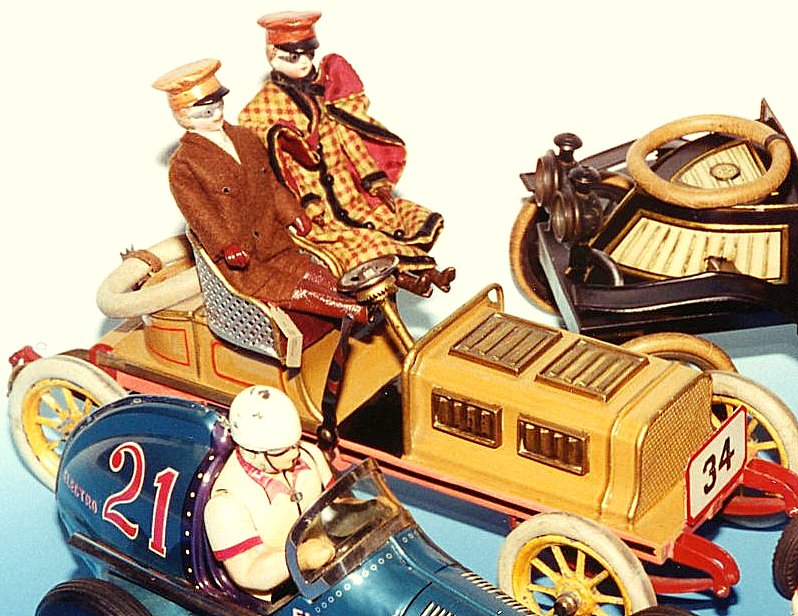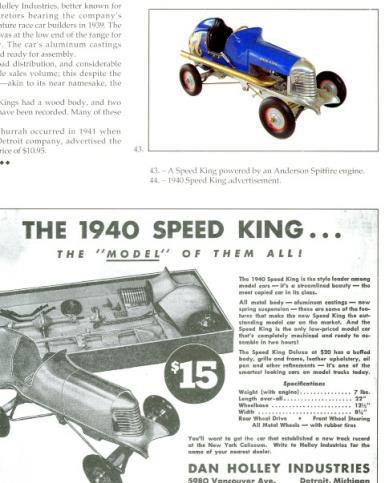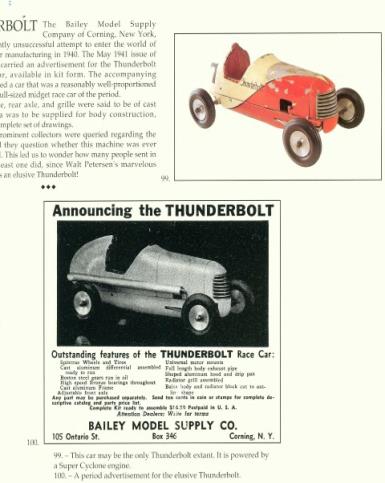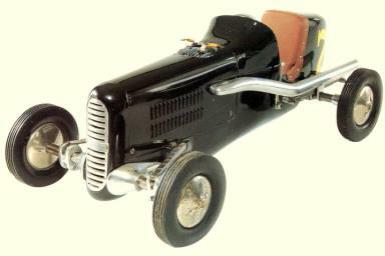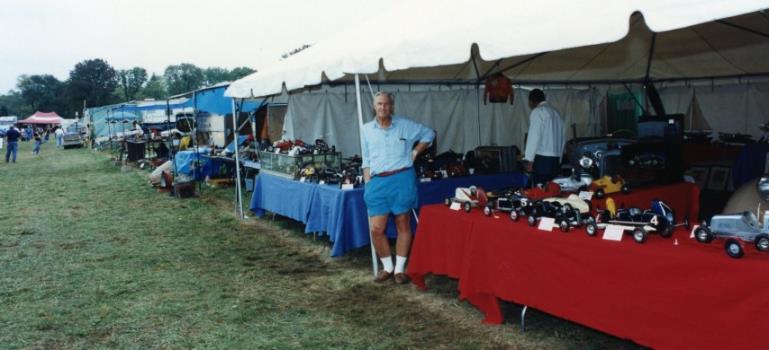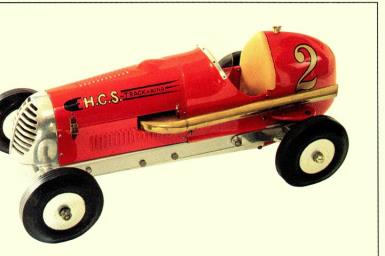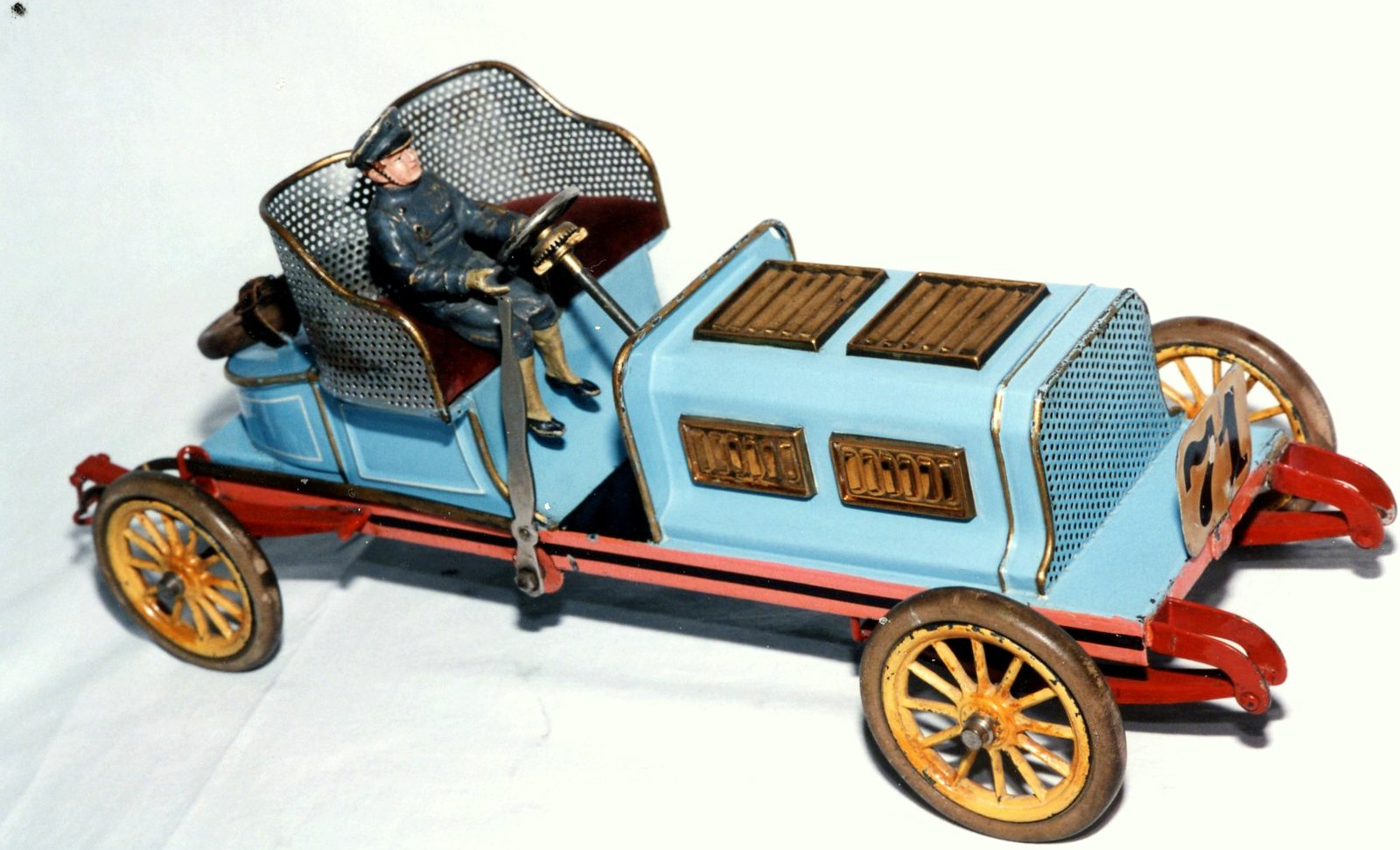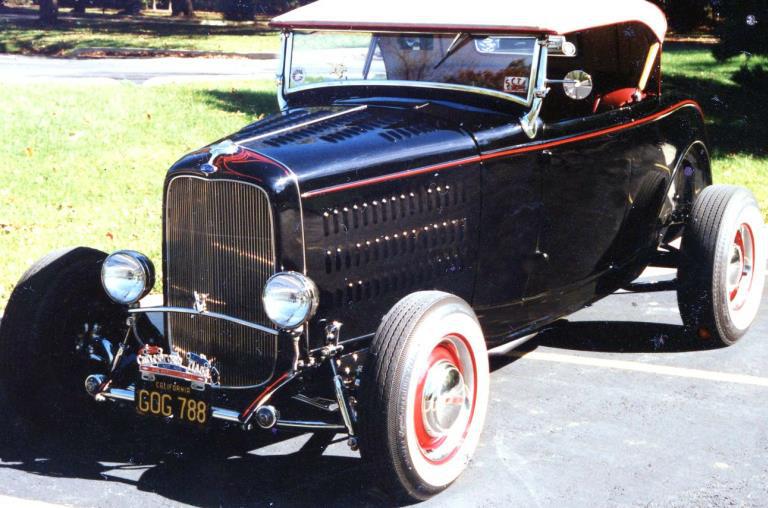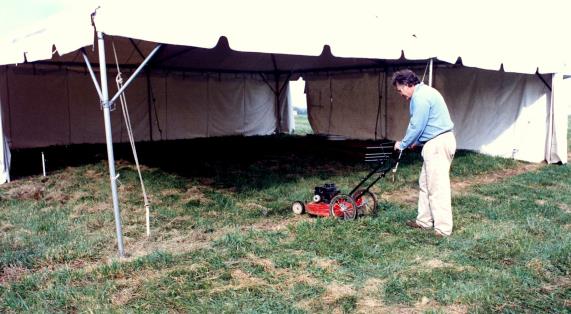781
A POTPOURRI OF TALES FROM THE GRAND TAPESTRY OF LIFE . . .
By the late eighties I hammered into my head the fact that if I was going to be an antique toy collector and dealer the only proper way to do it was to purchase the very best items that I could find.
Hadn’t I always practiced that with the automobiles?
My interest in the antique toy marketplace, spanned the era of the very highest quality European tin transportation toys which had been manufactured largely in Germany in the period from the 1900’s up through the 1930’s. And, of course, that, for me meant automobiles, preferably the rarest antique toy racing cars of the era. The most desirable, finely done toys came from such makers as Gebruder Bing, Marklin, Georges Carette, Gunthermann, along with many lesser makes.
The Germans had truly mastered the art of colorful lithography and, at the highest level of their offerings, the toys were hand enameled and equiped with strong clockwork wind-up power.
It was not long before I was additionally chasing the top of the line toy boats, aeroplanes, and then later on to the German toy trains, particularly from Marklin.
Though, I had truly believed the edict of, “just purchase the best.” But then in the interest of being “in the game,” so to speak, more than once I’d purchase an old toy that almost or just barely squeezed through my acquisition guideline window. I would soon tire of said purchase re-sell it.
Occasionally the profit margins were on the low side of okay, but often near break even or a loss.
The few times that I was offered an early toy of significance, the price would generally pull me up short.
As Marilyn and I began to dig deeper, we would travel to every Antique show we could find. In the process I was told that it would be wise to join the Train Collectors Association. It was the largest gathering of antique toy and train collectors in America.
Chapter 30
CONTINUE READING
782
Commonly known as the TCA, the vast organization held regional meets all over country, but by far their biggest meets were in Pennsylvania at the vast York, Pennsylvania Fairgrounds twice a year.
“You’ve got to join and attend the Spring and Fall TCA meets at York. Great antique trains, but there are plenty of antique transportation toys for sale also!”
In the midst of touring through my first TCA show in York, Pennsylvania, I was completely overwhelmed by the tremendous extent of the offerings spread over several exhibition halls!
I was checking the amazing merchandise in the main “Blue Hall” when I almost missed an older gentleman who had a small, but superb, offering of very old, very fine toys and European trains. Amongst his items for sale I spotted a small, exceptional, hand enameled racing car. It was only seven inches or so in length, but it had a real “ring” of quality.
“Hi, how much is this little racer?” I asked.
“$1, 000 . . . he said.
My face must have reflected my astonishment at his seemingly high price for a toy of such modest appearance.
Noting my astonishment, the gentleman was quick to add:
“It’s a Marklin . . .”
He introduced himself. His name was Bill Frey and he was one of those people who was a real pleasure to visit with. Bill went on to point out the highlights of the toy and the features that made up the magic of a Marklin toy . . . Then I remembered that I’d heard Bill’s name. He had a small, but superior collection of antique toys and lived in Pittsburgh.
I quickly handed him a check for the $1,000.
“If you get out to Pittsburgh, Kirk, come by and visit. I’d like you to see the collection.”
783
In the middle of the next row, a dealer who I knew slightly, pulled up in front of me, having spotted the small Marklin racer in my hand.
“Did you get that from Bill Frey?” he said.
“I don’t know, I just bought it from a table a few rows over, and I vaguely pointed in the wrong direction. . .”
“Whata ya want for it?”
“I really don’t want to sell it . . .”
That response was greeted with a snort. . . He was a gruff character, always smoking a cigarette.
“$4,000!” I said, largely to move him out of the way, which was greeted with a second snort and I started to push on up the aisle.
“Wait a second” the voice said, as the guy produced a roll of hundred dollar bills and peeled off 40 of them for me to fork over for the little racer.
I had just completed my first serious, “buy the best and . . .” antique toy transaction and my buyer, though a “rough around the edges” character, was a shrewd antiques dealer.
BUT THEN LOOK WHAT THE HELL I DID . . .
Marilyn and I travelled all the way to Shelton, Connecticut for a Lloyd Ralston antique toy auction. Ralston was a big player in the antiques business, particularly antique toys and periodically he would have marvelous auctions.
Well, we took “all our money” again and slugged our way through New York and out I-95 to Shelton. We saw at least a hundred items in the auction that we thought were wonderful and we carefully marked our catalog and got ready to strike the Mother lode!
784
You could have done a pretty darn good feature length comedy film of us failing to get anything bought! The prices just seemed out of this world!
Two lots from the end of the auction and not even cataloged, Lloyd Ralston held up in his one hand a raw ten inch Bing Edwardian racer, the tin hood, seats and frame, and the wind-up clockwork motor. There wasn’t a lick of paint on the car! There was really nothing that said “Buy me . . .”
Lloyd held the four wheels (two were bent) and ancient rubber tires in his other hand and with a pointed finger clearly showed the crowd the embossed “Gebruder Bing” maker’s badge on the chassis.
I had read just enough to know that in its day that bedraggled pile of tin had been a rare ten inch, hand enameled, two seater Edwardian racing car.
It was an expensive toy when it was new and there were not so many sold. Had it been complete it may have sold at that auction for $2-3,000. There was a good picture of one in David Pressland’s fabulous reference book, “The Art of the Tin Toy.”
(. . . Jeez, if I had a dollar for every hour I spent studying that marvelous tome . . .)
But, here it was the end of a long but exciting auction and not much interest was shown in the raw material Ralston had in his hand. The bidding opened at $25 and moved up slowly.
I secured the pile of scrap for $210.
Why did I buy it? Think back a few chapters and remember what Peter Canner did with our Gordon Bennett racer. At that point in the hobby very few people had access to a prized restorer with the talents Peter possessed.
As I did with the Gordon Bennett racer, I took my newly acquired pile of raw tin and "David’s Art of the Tin Toy" and laid them on Peter’s bench.
In beginning of his perusal Peter quietly commented:
“We’re getting pretty wide of tether racers here Kirk . . . I’m not sure how much I can do with this, but leave it with me and I’ll call you . . .”
785
( . . .Hhmm, Peter rarely used my name. Was that a bit of a warning that I may be pushing the envelope coming through the door with literally a handful of scrap . . .??)
Well, I was left to ponder that question for well over a month and a half before Peter called and said to come and have a look! I could detect just a whiff of pride coming down the wire.
I arrived the following morning. Peter led the way down to his shop and sitting there on a white towel on his bench was the Bing racer.
As most of you know, words rarely escape me, but in seeing this dramatic Edwardian racing car toy I was at a loss to convey my astonishment for the stunning work Peter had done.
Was it original now after all of this effort?
Of course not!! But we had saved a great and extremely rare antique toy from extinction.
So we enjoyed the early racing toy. We were proud to exhibit it to anyone showing the slightest interest.
We never spoke of it as a “pure” antique toy, rather highlighting the spectacular restoration.
The Crazy Second
THE CRAZY SECOND VERSE . . . DIFFERENT THAN THE FIRST!
On an exceptionally cold evening in November, we drove up into Bucks County to an Antique show at a high school that had been a community draw for a great many years.
Well, that year must have been a touch too cold for all concerned, as the show offered few vendors and fewer attendees.
786
Marilyn and I turned out of the main show floor area and walked down a long, dimly lit hallway toward another display area. Along the dark hall we came upon a group of tether cars! They were lined up in a haphazard fashion at the foot of some students’ lockers. It was a remarkably dark, awful spot to be offering anything for sale!
A scruffy, off putting character eyed warily. . .
All three cars were the big eighteen inch examples. Dusty, dirty, they had to have been recently just pulled from long term storage. They were sitting among all the other wares which had been pulled from a garage or barn.
Only one still had its engine mounted.
We wandered away . . . $1,000 was (again) probably just about all our money. I shouldn’t have been so much as even thinking about those race cars. I had no clue as to who made them or how old they were!
My shallow brain finally remembered that the one was a J.L. Engineering Special. Brand new JL’s had been just about the most expensive tether racers you could buy. As a youngster on my bike I would ride over 10 miles to the Keswick Cycle Shop simply to review and re-commit to memory every new tether racer they had in stock. I distinctly remember their one new JL car was $49.95 which was more than a good many men earned in a week!
The engine was missing from the tired clunk of a JL laying there in the cold school hallway!
One of the other cars was a combination of sheet metal and cast aluminum. Again, in spite of its shabbiness it was clearly a quality miniature racer, which turned out to be a Hawkins Cundiff and it did have an engine, but was missing a good deal of it’s the sheet metal bits.
And the third one was a Holley Speed King "same company as today's Holley carburetors" with a pretty badly smashed balsa body. The Holley Speed King dragged along in the rear of the pack with what appeared to be a very tiny Sky King gas engine.
787
It was easy to see that Marilyn had wisely dismissed spending all our money except pocket change on three dusty dirty unappealing old racers.
I kept going back to look at them. If you squinted your eyes very tightly the quality of the cars could just creep into your vision.
At the end of the evening, I broke down and paid our $1,000 for the three dirty cars. The ride home was pretty quiet . . .
Once home, I put them on the small shelves above my workbench and set to work. Bringing Peter Canner in to do the real work resulted in the three cars that you see pictured below, all of them are featured in Robert Ames’ book “Vintage Miniature Racing Cars.”
Each of the racers was superb and went on to make a great deal of money.
ALMOST BEFORE IT STARTED . . . IT WAS OVER
789
The breathtaking item, made in Germany, was a Gebruder Bing’s (“brothers Bing . . .”) largest clockwork, Edwardian, Gordon Bennett type auto racing toy. It was finished in brilliant French racing blue, hand applied enamel.
At nearly fourteen inches it was the most impressive antique toy I had ever laid eyes on. And, of course, it wasn’t for sale.
For a number of years, I continued to contact Bill, and bought a few nice toys from him, always pressing him gently on his blue Bing racer.
And then one fine day: . . .
“. . . I’m glad you called Kirk, I have an investment opportunity, and I will probably be selling the blue Bing racer. . .”
Bill had not offered the toy to anyone, and asked me to keep it to myself.
“I’ll be back to you Kirk, in 2-3 days.”
Early the morning of the second day Bill called and said he would sell the car!
That left the small matter of the price . . .
The Bing could be purchased for the sum of: $18,000.
790
BE CAREFUL WHAT YOU SAY . . .
Then early one evening my friend David Pressland, toy dealer extraordinaire, telephoned from London.
David had a customer in Germany who wanted our Blue Bing racer. I recognized the name and had heard the man was burning a blazing trail through Europe and America buying very good antique toys.
David was (and is one of my very closest friends and had often guided me through the choppy waters of my earliest days in the antique toy business.)
“Kirk, Heinze wants to buy your large Bing racer."
“David, you know I don’t want to sell that toy. I really love it and I could never replace it . . .”
David is a shrewd buyer and seller of world class antique toys and he ground on me relentlessly, finally saying:
“Kirk, there has to be a sum where you’ll part with the toy. Simply say what it is!”
I really didn’t want to sell it, which I continued to state.
But, I was beginning to sound like a spoiled child. So, I spit out a figure that should have wound up the conversation quickly.
“I would sell the car for $115,000 . . .”
Whoa Nellie, eighteen thousand dollars could buy a pretty decent Ferrari automobile in those days, to say nothing of adding a small wing to our modest home.
“Bill, give me to the end of the day and I’ll get back with you . . .” I said.
Well, Kirk, you’ve been preaching ad infinitum about buying the best and how you wanted to really establish a presence in the antique toy field. Here was a heck of a start.
My ego driven presence aside, I felt the toy would irrevocably rise in value.
I rang Bill and agreed to buy the toy.
On the trip back to Philadelphia with the Bing racer, I was wrapped in the euphoria that, for me, always comes with each significant purchase, be it a Ferrari automobile, a group of tether cars, or ,in this case, a great antique toy. To this day, any time I travel home with a great piece or collection, it’s truly a wonderful journey . . .
791
Silence on the other end. (. . . I’d definitely tipped the cart over with that preposterous figure. . .)
Still silence.
“David, are you there?” I said.
He responded as only a through and through Britisher could:
“. . . Yes, I’m simply trying to catch my breath . . .”
After a bit more back and forth, the price was set at $105,000!
And yes, it was outrageous, but stick around.
I received a fax later that week with the customer’s address in Germany.
That same evening I was downstairs at my workbench when the phone rang. I picked it up and could tell by the faint “crackling” on the line that the call was coming in from overseas.
It was “Heinze”, the purchaser of the Bing. Could I mark the value on the customs at $1,500 and he would wire the funds the following day?
Hmm, well, it was overseas, and it was clear he was going jack the deal sideways if I refused.
“Very well . . .” I said and everything went smoothly from there on out.
For a while . . .
Nearly two years later I was in our town of Wayne, Pennsylvania early one morning at the Molin Body Shop. I often made Molin Body an early stop as I had been able to snare some lightly damaged late model Mercedes Benz, Porsche etc.
I’d only been there a few minutes when Jim Soley hailed me to his office.
“Call your wife . . .” he said.
792
Hhmm, what was up at eight forty in the morning?
I called Marilyn and she picked up on the first ring:
“There are two gentlemen here from the United States Customs Bureau.
You need to come back and talk with these men . . .” said the icy voice at the other end of the line.
It was one of those terrible moments where life and your brain felt like it had been plunged into a sea of cold molasses. It seemed to take hours to drive the two miles to home.
Yep, there was a big black Ford law enforcement vehicle, US Government license tag. The whole deal.
The next hour was “Federal” through and through. Two gentlemen, one black. Both extremely polite. We were asked to produce everything we had on the toy deal with “Heinze.”
Poor Marilyn ended up in our basement back in the crawl space seeking faxes, bank records, etc.
Each item we produced they already had in their possession and simply wanted to confirm that our ducks were in the same order as their “ducks.”
(. . . Know that every question you are asked by any Federal agent, straight across the board, they already have the answer in hand . . .)
Finally, they had all of the information they needed. I had drifted into imagining how many years I was going spend in a Federal facility . . .
The lead guy crisply broke my train of thought with the notice that they were there representing the German government, assisting in building a case against “Heinze”, who, it seemed was in a bucket load of trouble!
“We are only gathering data for the German authorities. At some point we will ask you to come down to the Customs office in Philadelphia, go on the record, and that will be the end of it.”
793
After the wave of relief passed through the room, the black gentleman leaned forward in his seat.
Staring straight into my eyes he said:
“You mean to tell me that you bought a toy car for $18,000 and then sold it for $105,000!??”
I was still riding the wave of relief, or I may not have been quite so flippant! But after hesitating a moment or two . . .
“Wouldn’t you?” I said.
Fortunately everyone had a chuckle. He agreed that he might, if he had the chance.
A month or so later I went down to the Customs building and committed it all to the record.
When it was all over “my” agents walked me to the elevator. As we were waiting for it to arrive, it suddenly occurred to me that I periodically traveled to Germany for various auctions, toy shows, etc.
“Do you suppose from now on I would be considered “persona non grata” in Germany?”
Both agents looked at each other thinking about it and they concluded they didn’t really know, but one said:
“You might not want to plan going there in the next few weeks . . .”
IT HAD TO HAVE BEEN CLOSE TO THIRTY YEARS. . .
. . . since we’d all been together. Bill Jellett, Heb Fricke, Charlie Knopf and myself.
Of the four, Bill Jellett was the most active in staying in touch with all of us, always having a good joke and plenty of gossip. He went to school with me in 1957 at Germantown Academy in Philadelphia. The noted hot rodder, Jack Kulp, had built a ’48 Ford coupe with one of his potent Olds engines, coupled to a strong La Salle gearbox, for Bill.
794
Bill called early in September in 1990. He’d had a thought:
“We should get a dinner together with you, Heb Fricke, Charlie Knopf and myself. . .” Bill would see what he could do to make it happen . . .
I totally agreed, listened to Bill’s “joke of the week” and returned to whatever it was I’d been doing.
Shortly, on the Monday of the week we were headed for Carlisle, Bill called again.
“OK, it’s all set for this Wednesday! Dinner at the Blue Bell in Skippack. . .”
I explained to Bill that I’d be at the Carlisle swap meet all week.
“I really want to do this, but I’ll be in the middle of the event at Carlisle” I said.
Back and forth calls determined that the coming Wednesday was our only window.
“OK, I’ll be there. . .” I said
“Great,” said Bill, “don’t forget the Blue Bell is coat and tie for the men!”
I very nearly said:
“No, that straw just broke this camel’s back!”
795
I’d be all day working at a down and dirty antique car swap meet, change into a white shirt, necktie and blazer, drive 100 miles, have a great get together with old friends, and drive 100 miles back to Carlisle!
You’ve met both Heb Fricke and Charlie Knopf back in the chapters covering the early hot rodding days. Knopf I’d known since the mid fifties and to this day remains one of the grand players on the stage of my life, surfacing throughout virtually every chapter of my life consistently, always unexpected and hugely entertaining each brief time I’d encounter him.
Heb, of course was my oldest friend and we had shared so many adventures in the day . . .
Bill, Charlie and I arrived at the Blue Bell. Heb was running a touch late, coming from a golf game.
We had a drink, and talk quickly came around to what a terrific friend Heb had been to all of us.
Before I left Carlisle that day, I had remembered that Heb had lent me $65.00 in our drag racing days to buy yet another set of McCullouch ball races for my Thunderbird supercharger, and I had never paid him back.
I’d pay him tonight at dinner. . .
HERE’S WHERE IT GETS OUT OF HAND . . .
Charlie piped up with this. (It should be noted that Charlie had gone from good to very good and then extremely well in his business life over the years.)
“Heb lent me $160.00 in 1956 and I never paid him back.” Charlie admitted.
796
Charlie continued . . . “So, a couple of days ago, I said to my bookkeeper, Harriett:
“How much would $160 be worth after thirty-two years at 10%?”
Minutes later she laid the figure down on Charlie’s desk. It came to a staggering figure just under $3,400!
“I gave it back to her and said:” 
“Do it again at 5%”, said Charlie.
“So how much is your check?” I said.
“$700. Something. I got it with me.” Said Charlie!
“That’s really fuckin’ terrific, Charlie” I said.
“So you’re the hero and I’m a schmuck. I’ve got $65 in my pocket!!”
At that point Heb arrived. More drinks and Charlie wheels out his check to Heb knocking me straight into the dumpster! I forked over my lowly sum and Heb laughed and pushed the money back toward both of us.
“You guys are crazy. . .” I’m not taking any of that money.
Then after his fourth refusal as we were reaching to take it away, Heb’s hand shot across the table and snatched it back.
“I just thought of a charity I’d like to give that money to!” He swiftly pocketed the money!
797
HERSHEY, FALL 1990 . . .
As the eighties ended, the Blue Field, where Dick and I were located, was closed. Hershey was going to develop the property commercially. Dick and I were re-located to spaces in the “new” large, “Green Field.” That large area had opened even more vendor spaces, expanding the number to greater than nine thousand!
It has been said that if you can’t find the automotive treasure that you’ve always wanted at Hershey, it doesn’t exist!
One might further say that at every Fall Hershey meet, virtually without fail, you may well find something that you may not “need,” but you are so captured by “it” that that you simply buy it!
So, Tuesday, October 9, 1990 found my wife Marilyn and I setting up in the midst of the Hershey Green Field along “Race Car Row.” The “new” field was simply old, over tilled, overgrown farmland. The grass was coarse and thick and we literally had to mow it!
By the middle of the following day as far as the eye could see, the entire area would look like a vast gypsy camp filled with antique auto enthusiasts.
We were fortunate to have our spaces on the newly assembled “Race car Row.” “Race Car Row” was a loose grouping of folks whom the great racer Lynn Paxton felt were worthy of representing automobile racing over a broad spectrum. Lynn ruled both Carlisle and Hershey in the matter of who was placed where in connection with all aspects of racing vendors.
798
It was mid-afternoon by the time we had set up our tables, etc. and visited with other vendors who were going through the same set up ritual.
When we finished we followed another of our established rituals, and got in our car and very slowly began to drive around the field to see what choice baubles may have been brought to Hershey to be offered, sold, or traded.
An old friend, Jim Lowrey, and his son Jim, Jr. from Massachusetts were always high on my list of vendors to check out.
I knew they would be located somewhere on our field. I had known Jim, Sr. for a good many years and knew anything the Lowery’s had with them at Hershey would be top shelf.
Jim Lowrey was your quintessential New England Yankee. A man of few words, but he and his son, Jim, Jr. were superb craftsmen. Both had been championship winning race car drivers in the New England area which was a mighty tough and competitive area.
Their automobile restoration work was simply the finest, with senior handling the mechanical end and Jim Jr. the metalwork and paint.
Through the years I had bought some wonderful antique items from Jim, Sr.
But here was the thing, and it wasn’t exclusive to Jim Lowrey. Each year, I’d call Jim a week before Hershey . . . “Jim, are you bringing anything to Hershey that I might have an interest in?” I’d ask.
“No, nothing special . . .” would be the universal reply.
799
I learned to never pay attention to that type of response from him or others who always responded in a similar fashion, and frankly I was guilty of it from time to time.
I spotted the Lowery’s camper and we bumped over the field toward them. As I turned into their space there sat a car that was about to turn my automotive life in a new direction.
SERIOUS DIVE FROM THE FRYING PAN TO ANOTHER FIRE!! . . .
The car was a, no nonsense, 1932 Ford hot rod highboy roadster with what appeared to be a “full house” Ford flathead engine. To cap it off the damn car was black with a red interior. It was everything a quintessential late forties, early fifties California, all American “highboy” hot rod was supposed to be.
I never would have pictured Jim Lowery having a hot rod. I looked at the car some more, and the more I looked, the more I loved it.
“Is this hot rod yours?” I asked.
(No, Kirk, it was layin’ here in the middle of the field when they got here, you idiot . . .)
“Yep, I built it a pretty long time ago, and I’ve had some good years with it. The primary reason why I built it is kind of interesting.”
800
Jim went on to say that a buddy of his in Massachusetts, Bob Magane had bought another old ’32 hot rod roadster out west. “He sold me this terrific modified flathead motor out of that car.
Bob said that his hot rod had won some timing tags on the dry lakes in California in the early fifties and he was scared that if he continued to run the full house flathead, he’d scatter it!
He put a small block Chevy motor in his rod, so he didn’t have to worry about it.”
Jim went on to say: “I didn’t pay too much attention to Bob’s story, but when I rebuilt this flathead, sure enough somebody had taken an electric pencil and put in the date and the speed the car had run!”
“Is it for sale?” I asked.
“I guess so, that’s a Wescott body you know . . .” said Jim, Sr.
Jim Lowrey said he wanted $28,000 for the car.
I had no idea what a Wescott body was. Who cared? I was so taken with that time warp of a hot rod, that Jim could have said almost any figure, and I would have found a way to rationalize it.
“Take 25 . . .” I said.
“Nope, 28 . . .” Jim said.
At that point other people were gathering to look at the hot rod. I quickly said OK, and paid him. It was such a rush to just get behind the wheel, to feel the solid “chunk” of the door on that ’32 and look out through the chopped windshield.
801
Golly, how long had it been since I’d heard a flathead starter motor ring off the flywheel. The motor was very responsive and balanced beautifully.
I slowly drove the car over the uneven field racking up plenty of thumbs up, waves, etc. We opened our tent enough to get the car inside and in came four people with it!
“Is that hot rod for sale?” Someone asked.
“Uh, no, I just bought it, and I think I’d like to keep it for a bit.” I said.
“Beautiful car,” someone else said.
We closed up the tent and set off to have an early dinner.
Early Wednesday morning we opened for business and started to put out our items we had brought with us. Some gas engined tether cars, and antique tin toys, literature, etc.
Pretty quickly a number of people were in our tent. More than usual for a Wednesday, and they were all over the hot rod. I needed to get back over to Jim Lowery’s spot and get an education as to exactly what was parked in our tent! I wasn’t that well informed on the true specs of this hot rod, and questions were being fired at me incessantly.
The people kept coming throughout Wednesday, Thursday and Friday!
“Is this hot rod for sale?”
802
“Golly, I haven’t seen a real hot rod since I was in high school.”
“How much is this roadster??”
“That ain’t no street rod, pal. That there is a real hot rod!”
I wondered what a street rod was. I wasn’t familiar with the term.
Friday morning I was beginning to come out of the ether. I realized that if I’d had a handful of these suckers in the tent this weekend I probably could have sent them all off to new homes. Maybe I’d better put a little effort into finding out just how many of these hot rods might be out there.
Several more folks had pointed out that this was a “hot rod” and not a “street rod.”
We closed out a great week at that Hershey meet, and I have to say, I couldn’t believe how many people came to visit our tent to carefully look over the hot rod. There were a good many questions about the car that I couldn’t answer, but often those questions were addressed by someone else in the tent that was looking at the car. It seemed a good many people were hip to hot rods.
By the time we closed up at the end of the week and headed home with our new “hot rod,” I was totally captivated by the car itself, and very cognizant of the fact that I had let hot rodding slip far too deeply into my past, having last been active in the late nineteen fifties!
And, what was it that everyone kept saying this car was not?
803
Oh yeah, they were saying this was a “real” hot rod, not a damn “street rod . . . “
So, as I had done with every other inbound interest in my life, I got hold of every piece of reading material including the then current “rod” magazines. I quickly found out that basically street rods were loaded with all kinds of modern items such as late model engines, sub-frames independent suspension, air conditioning, power windows, stereo, ad infinitum.
You could build an entire “street rod” from a single catalog!
Many of the street rods were based on older Fords, but it seemed they were powered almost exclusively by Chevrolet engines!
If your street rod was a sedan you could take the whole family out, and glide along in air conditioned comfort, listening to Andy Williams, and adjust the air conditioning and that tilt steering wheel.
Pastel Easter egg paint schemes seemed to be a common finishing touch . . .
There were thousands and thousands of street rods out there. Street rods had become a major hobby coast to coast.
THE OTHER END OF THE SPECTRUM . . .
My drive home in my “new” old style hot rod amply demonstrated the differences. As an old fashioned hot rod, my early Ford suspension had me rockin’ on down the road with transverse buggy springs, front and rear, backed up by early tubular shock absorbers. The same type used by hot rodders in the fifties.
804
My steering utilized a 1956 Ford pick-up truck steering box which hooked up to the 1932 solid axle setup. There was a bit of “bump steer.” And it kept you a tad busy.
The power coming from the healthy flathead was being transmitted through a 1939 Ford 3 speed transmission that lacked a synchronizer on first gear.
Objectively, a case could easily be made for those “Street Rods” with modern sub frames, with independent suspension, air conditioning, automatic transmissions . . .
And yet, this “old” hot rod took me back to my days in the fifties. To the times at the drags, Freddie Allen and his Devil Deuce, Jules Donofry, Andy McNally, Bill Bryden. You couldn’t help but smile if you were driving that ’32 Ford highboy.
Once home with the car, I found myself driving the rod every chance I had.
It was just good spending time with the hot rod in the garage.
WELL, WHO WOULD HAVE GUESSED . . .?
The weekend following Hershey there was a regional Ferrari Club of America meet on the other side of town, and for a good many people, myself included, it would be the first opportunity to see the newly introduced 348 GT Ferrari.
805
I drove the ’32 Ford hot rod to the meet. The event was being held at a golf club in suburban Philadelphia. Driving in to the club, I thought, “I don’t want to create a ruckus with this rod, I’ll park it way over there . . .” and I quietly drove the hot rod way, way far away from the show field and parked.
It didn’t work. People saw the hot rod coming in and nearly everyone attending the Ferrari meet came streaming over to look the ‘32 over!
Virtually all of them were taken with the hot rod. I was ready for someone to say that the car was entirely inappropriate for a Ferrari gathering.
It was becoming abundantly clear, that I’d best get to work and make a serious effort to scare up some more of these hot rods!
In the early seventies I’d taken a brief crack at trying to isolate a handful of the more famous racing hot rods. Many of the hot rods that had gained fame in the fifties and sixties were still active in competition!
I remember calling Dean Batchelor in early 1974 asking for his help in trying to run down some of the great hot rods.
“Forget it, the few that have remained original, have been snapped up.” Dean told me.
That was in 1974, mind you! So, I did. I forgot about it.
Now in the fall of 1990 I wasn’t prepared to give up so easily on trying to unearth a few true hot rods.
806
A whirlwind round of telephone calls did turn up two more pure hot rods. I quickly learned that there were more than a few “ol” hot rods out there, but damn few of them were still “original.”
Probably more so than in any other facet of the motorsport hobby, hot rods were the subject of almost daily fresh thinking, followed by continuous modifications, tinkering, total re-engineering, etc.
In all phases of auto racing, there is the expression: “There’s nothing older than last year’s race car.”
In hot rodding, it could have easily been: “There’s nothing older than last week’s hot rod.”
I put together “Wanted” advertisements to run in several publications such as Hemmings, Old Cars, etc. stating:
“Absolutely highest prices paid for early Ford American original hot rods from the forties through the early sixties. Particular interest in dry lakes, and Bonneville cars. Also cars with magazine history, Oakland Roadster Show cars, etc.”
The ads then elaborately reiterated: “ABSOLUTELY VERY HIGHEST PRICES PAID!!
The ads began to work. In the early nineties there were still genuine historied hot rods out there and they could be bought. There were no price guides or really any market base with early hot rods at that point in time. You simply had to go with your “gut” feeling.
807
I became consumed by the early hot rods, and began to pursue every possible lead I could turn up. And I continued to voraciously consume every printed word on early hot rods that I could find.
THE CONSUMMATE HOT RODDER . . .
Bruce Meyer was already a hot rodder when we met in the eighties. He owned Andy Cohen’s ’32 Ford highboy. Bruce said to me: “Come out to the Los Angeles Roadster Show over Father’s Day Weekend. It’s the greatest rod show in America!”
So I gathered up sons Geoff and Chris and off we went to Los Angeles, Father’s Day weekend. I was so stoked by the time we got to LA that I made the boys get up at 4:30 Saturday morning for the show. We were just a tad ahead of the curve, landing ourselves third in the line for admission to the Los Angeles County Fairplex in Pomona, just past a chilly foggy, cloudy dawn. The gates didn’t open for another hour!
The boys were looking at me like:
“This is really cool, Dad. Is this pretty much what the weather is like out here?”
It wasn’t long until the sun burned through and the LA Roadster Show unfolded before us. There were row upon row of superb hot rod roadsters in the show itself, plus massive manufacturers tents.
That tent held products that offered everything from speed equipment, chassis, bodies, etc. all the way up to complete turnkey street rods. It was sensational. There was no way to absorb it all, but it sure was fun trying. Both of the boys happily branched off to pursue whatever caught their eye.
788
So we rolled along through the hundreds, then the one thousands. I started to run out of air. He asked for $2,000 and another person dropped out, 4 remained in, and on to $2,200 while everyone stayed in. I folded when he went to $2,300. We were allowed to stay on the line to hear the final price. It went to $2,400, $2,500, $2,600, $2,700 and then at $2,800 landed with Walt Petersen my friend and dedicated tether car collector in Reno, NV.
That “auction” yanked me around the last bend in my path, and I went full tilt after the tether racers from that point on.
(. . .Let’s not forget that I had been a World Champion tether car racer at age 12 having won the worldwide Cox Thimble Drome competition held in Philadelphia’s Convention Hall . . .
(Chapter page DWM, Chapter 3, p57-59 . . .)
A good many years later, I was fortunate enough to own that super rare Thunderbolt and it is the one pictured in the Ames book.
Suffice it to say say I paid a great deal more to bring it home than Walt had paid.
SO, WHAT ABOUT THE BIG, BLUE BING 1907 “ON THE LAM” RACER?
Okay, so here’s the story of the great, glorious blue Bing racer. It starts with Bill Frey, the gentleman from whom I had purchased that early Marklin racer.
Periodically I had called Bill to see if he might be selling any additional antique toys. The calls yielded very little in “new” acquisitions, but he always mentioned that, though I lived in Philadelphia, if I ever found myself in Pittsburgh to come visit him.
I did visit Bill after buying a Jaguar in Latrobe. Bill’s collection was superb. Not tons and tons of old toys, but rather maybe fifty antique toys covering early autos, early railway. However, there was a centerpiece in his gathering of antique toys.
A couple of weeks later, I was hailed at Renningers Flea Market out near Lancaster, Pennsylvania by a very clever antique dealer.
He did not deal in gas engine racers, but had taken the time to educate himself and was thinking of auctioning a race car he had found at a house sale. He was going to conduct an auction on the telephone! The following Sunday he hailed me again and informed me that on that Thursday night at 7:30 he would telephone six or seven of the collectors he knew for his auction.
The procedure would be that he would present an opening figure. The bidders would then say they were still in or would say, “I’m out”.
No questioning, no kibitzing.


